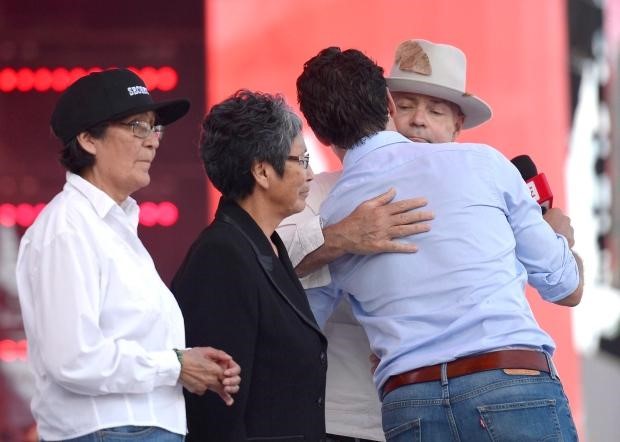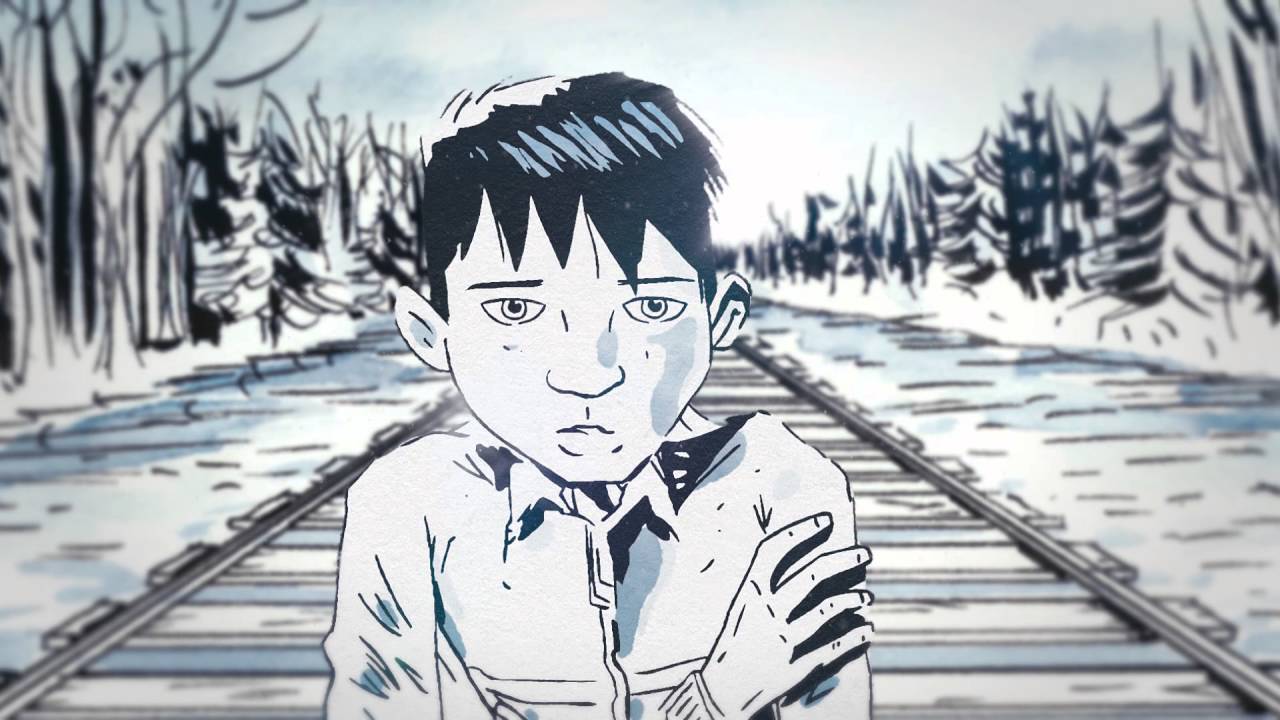Pearl (Wenjack) Achneepineskum says Gord Downie’s illustrated book about her brother Charlie whose frozen body was found lying beside a railway track near Kenora, Ontario, on October 23, 1966, is too graphic for young children.
“Secret Path is so graphic that I thought that the children would not be able to handle it,” she told a CBC reporter before joining students at Toronto’s Dundas Junior Public School earlier this year. “I was hesitant in introducing it to the children … I just thought they wouldn’t handle it. There was just too much pain for them. It couldn’t register for them.”
Jeff Lemire’s drawings in Secret Path – which is being used in more than 40,000 classrooms across Canada — show nuns in habits delousing naked Ojibway boys covering their genitals with their hands. A male with a white crucifix on his chest drags a screaming child into a building. A nun in a habit pulls a half-naked boy’s ear and makes him yell in pain.
Gord Downie’s lyrics have Charlie saying: “I will not be struck. I’m not going back.” In one of the drawings, a white male in a clerical collar with a crucifix on his chest approaches Charlie’s bed. The young boy looks up at him fearfully.
Having attended the former Indian residential school on the outskirts of Kenora herself, Ms. Achneepineskum knows there were no nuns or priests at Cecilia Jeffrey. She also knows her brother attended a public school in Kenora and only boarded at Cecilia Jeffrey – which was operated by the Women’s Missionary Society of the Presbyterian Church in Canada.
Later in the book, a cleric looks menacingly through the trees as a shivering Charlie is shown shuffling along the railway tracks in his fatal attempt to return to his far-away home. Gord Downie’s lyrics say: “I heard them in the dark. Heard the things they do. I heard the heavy whispers. Whispering, ‘Don’t let this touch you’.”

Pearl (Wenjack) Achneepineskum, in black, watches as Prime Minister Justin Trudeau embraces Gord Downie at We Day on Parliament Hill on Sunday, July 2, 2017. Sister Daisy is in white. Photo by Justin Tang of The Canadian Press
Nothing that was written or said at the time of Charlie’s death suggests that he was physically or sexually abused while boarding at Cecilia Jeffrey. Nor is there anything suggesting physical or sexual abuse in the section about him in the 2015 report of the Truth and Reconciliation Commission.
According to an October 18, 2016, report by the CBC’s Jody Porter, Ms. Achneepineskum told a packed Gord Downie concert in Ottawa: “My father died in 1987 without ever knowing why his son had to die. My mother still waits. To this day no one has told her why her son had to go.”
In an October 20, 2016, interview with the CBC’s Carol Off, Ms. Achneepineskum said her mother had not been told how her son had died and quoted her as saying: “How come they never told me why he died?”
However, according to a letter Cree/Saulteaux Colin Wasacase — who was in charge of Cecilia Jeffrey at the time — wrote on November 17, 1966, — the mother was in a hospital at Sioux Lookout and was informed of her son’s death the day after his body was identified.
According to Mr. Wasacase, the mother wanted her son’s body returned to their home at Ogoki Post and requested that her three daughters, who had been staying at Cecilia Jeffrey, be taken to see her at the hospital in Sioux Lookout.
Mr. Wasacase – who attended residential schools as a child and taught at two of them as an adult — took the three sisters plus one who had been living at Red Lake to see the mother the next day and plans were made for taking Charlie’s body to Ogoki Post.
Police and Indian Affairs’ officials were having difficulty contacting the father at far away Ogoki Post – where Charlie’s school-age sister Pearl was living at the time because her name wasn’t on the list of children to be boarding at Cecilia Jeffrey that school year.
Mr. Wasacase, Charlie`s mother and five of his sisters flew by plane with his coffin from Nakina to Ogoki Post on Wednesday morning. An Anglican minister had joined them at Nakina to officiate at Charlie`s funeral.
In his letter – which is filed in the archives of the Presbyterian Church in Canada — Mr. Wasacase said Charlie’s father was very upset because he had received no notice that his son would be arriving in a coffin. That was compounded by the fact that he received a letter from Mr. Wasacase written five days before Charlie’s death saying all of his children at Cecilia Jeffrey were well.
“The father felt that I wasn’t being honest with him and held me responsible for his son’s death, due to my letter saying all was well,” Mr. Wasacase wrote.
When the family viewed Charlie’s body during the graveside ceremony, they noticed the stitches from the autopsy and concluded that he must have been stabbed.
“So they were not going to allow the boy to be buried or my return [emphasis added] until somebody phoned the O.P.P. and confirmed what I had said about an autopsy,” Mr. Wasacase wrote.
When they got through to the OPP on the radio phone, the family was assured that Mr. Wasacase had told them the truth about how Charlie died.
After the funeral, the father exercised his rights and said he was not going to allow sisters Evelyn, Annie or Lizzie to return to Cecilia Jeffrey.
There’s a night and day difference between Mr. Wasacase’s contemporary account in the Presbyterian Church archives and what Pearl Achneepineskum told the CBC and the audience at Gord Downie’s Ottawa concert 50 years after her brother’s death.
Children reading Secret Path are being taught that Charlie died “trying to escape” the horrors of an Indian residential school.
However, there were no prison-like conditions at Cecilia Jeffrey from which he would have found it necessary to “escape”.
According to the report of the Coroner’s inquest in the Kenora Miner and News, Colin Wasacase said it was common practice for the children to wander off into the bush and run-away students were a major problem.
Letters written by Mr. Wasacase at the time say the children were free to leave at will and often went to visit friends or to hang out in Kenora.
Charlie had been at Cecilia Jeffrey for three years and made no attempt to run away before the sunny Sunday afternoon of October 16, 1966, when he was playing on the swings at the playground with two orphaned brothers. One of them had run away three times in the last few weeks and the other played hooky on a regular basis.
The brothers decided to go and visit their uncle who lived about 30 kilometres away from Cecilia Jeffrey. Charlie’s best friend testified at the inquest into his death that he was lonesome and “when the other ‘guys’ were running he decided to go along.”
In an article published in Maclean’s in February, 1967, — which Ms. Achneepineskum says she has read — writer Ian Adams said: “Right there on the playground the three boys decided to run away.” They left wearing only light clothing despite the fact it was late October and the nights were freezing cold.

Gord Downie performs at WE Day in Toronto on Wednesday, October 19, 2016, with a drawing from Secret Path on a giant screen. Photo by Chris Young of The Canadian Press
Despite the fact Charlie didn’t head for home until five days after playing on the swings with his friends at Cecilia Jeffrey, Secret Path says he died “trying to escape the Cecilia Jeffrey Indian Residential School.”
And his sister Pearl often joins the children in the classrooms adding credibility to the fabricated tale that’s being spun.
In a taped interview with Global News on October 18, 2016, Pearl Achneepinsekum said Secret Path is an accurate account of what happened to her brother. “Even though the pictures are very graphic,” she said, “they do tell the truth. Whoever did this got the real picture of what happened.”
In the October 20, 2016, interview with the CBC’s Carol Off, Ms. Achneepineskum said: “The story of Charlie should have never happened. The death that he went through and the pictures that were done were very graphic but it was the stark truth [emphasis added].”
Meanwhile, in classrooms across Canada, Ms. Achneepineskum joins the children as their teachers take them through an illustrated book she knows doesn’t even come close to telling “the stark truth” about what happened to her little brother more than 51 years ago.
View the PDF version here: EF15TooGraphicMacBain



